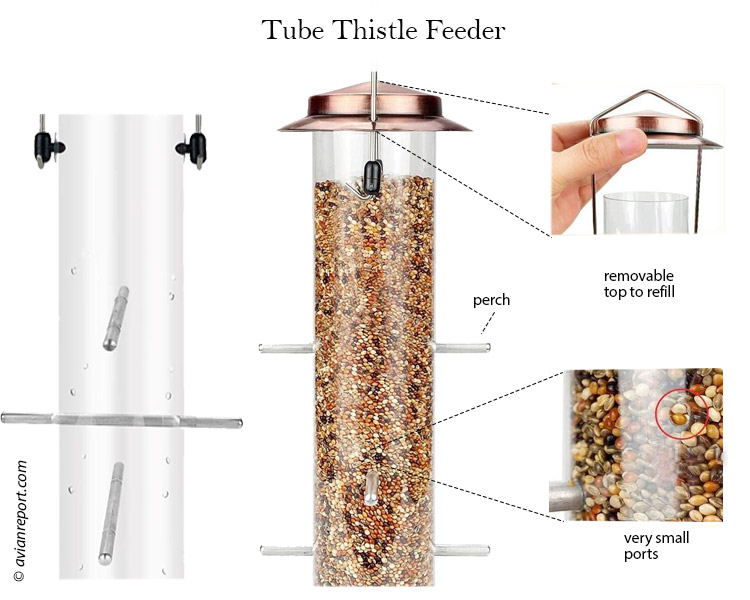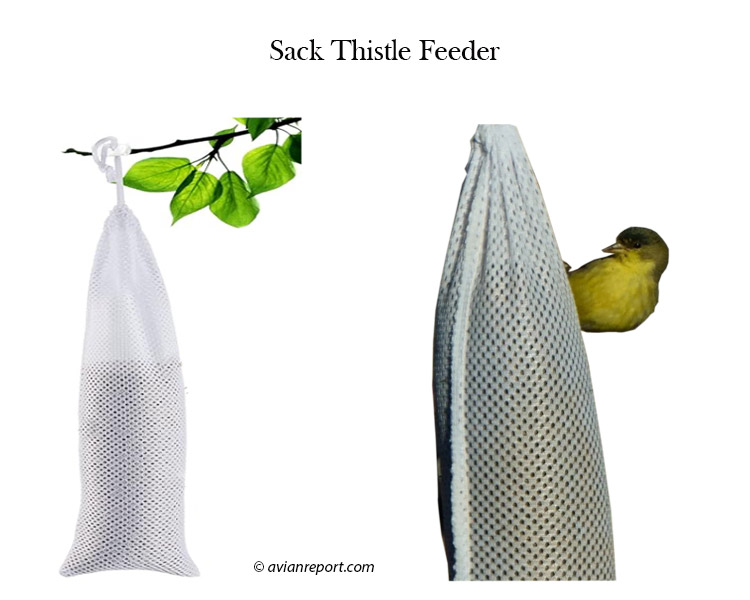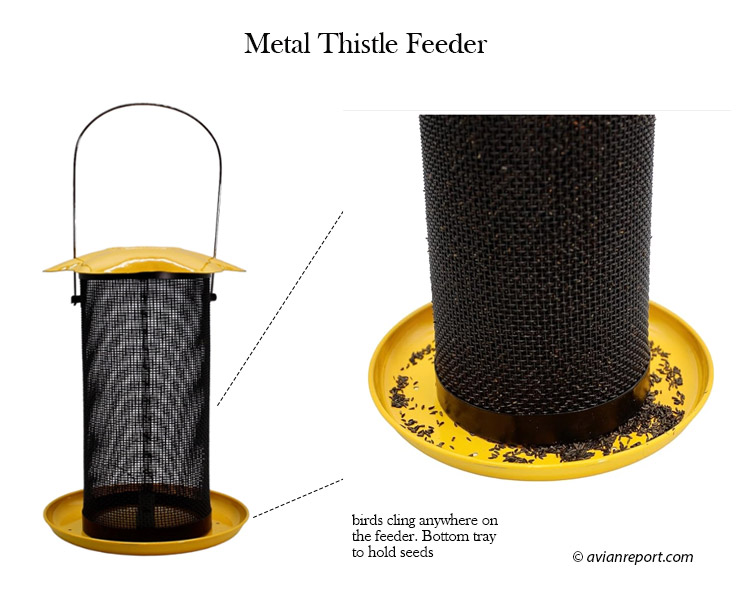Thistle bird feeders are designed for Goldfinches, Pine Siskins, and Common Redpolls. These types of feeders have very small holes designed to dispense only the tiny black thistle seeds, also known as nyjer seeds.

What is thistle bird feeder?
There are two main types of thistle feeders:
Tube Feeder: This is the most common type of thistle feeder. It resembles a standard bird feeder with a long, clear plastic tube that holds the nyjer seed. The tube is equipped with multiple feeding ports along its side. These ports have small perches where finches can land comfortably while they feed. The small size of the ports and the special design help prevent larger birds from accessing the nyjer seed.
Sack Feeder: This type of feeder looks like a fabric sock with a mesh body that holds the nyjer seed. The mesh allows the finches to access the seeds while keeping the seed contained. Similar to the tube feeder, the sock is designed to restrict access for larger birds.
Related:
Fruit & Jelly Bird Feeders
Hummingbird Nectar Feeders
Window Bird Feeders

How does it work?:
- Filling the Feeder: The feeder has a removable top that allows you to fill it with thistle seeds, also known as nyjer seeds.
- Gravity Dispenses Seeds: The seeds fill the inside of the tube feeder. Small holes or ports allow the seeds to trickle down into the perches as birds eat them. This gravity-fed system ensures a steady supply of seeds near the feeding ports without overflowing.
- Birds Access the Seeds: Finches and other small birds land on the perches provided outside the feeding ports. They reach their beaks through the small holes to access the seeds within the feeder.
- Seed Catch Tray (Optional): Some tube feeders have a tray attached below the feeding ports. This tray catches any seed husks or shells that fall from the feeder, keeping the ground beneath the feeder tidy.
Description of tube thistle feeder
- Material: Typically made of clear plastic or polycarbonate for easy seed monitoring.
- Design: A tube-shaped feeder with small feeding ports spaced along the sides.
- Features: Multiple feeding ports (usually 2-4) with perches for goldfinches to cling to while feeding. Drainage holes may be present at the base to prevent water accumulation. Some feeders have a removable base for easy cleaning.
- Size and Variety: Tube thistle feeders come in a variety of sizes, from small feeders holding just a few cups of seed to larger feeders that hold several pounds.
Related:
Suet Bird Feeders
Globe Bird Feeders
Hopper or House Bird Feeders
Sack Thistle Feeder

- Material: Made of mesh fabric, usually polyester or nylon.
- Design: A fabric sock filled with thistle seed.
- Features: May have a plastic or metal frame to hold the sock shape and a hanger for attaching it to a pole or shepherd’s hook.
- Size and Variety: Sack feeders come in a variety of sizes, with a standard size holding around 2 cups of seed.
Seed Type:
- Both tube and sack feeders are designed specifically for nyjer seed, also known as thistle seed, a favorite food of goldfinches.
Seed Capacity:
- Tube feeders: Capacity varies depending on size, but typically hold 0.5 quarts to 1.5 quarts of nyjer seed.
- Sack feeders: Typically hold around 2 cups of nyjer seed.
Refilling Recommendation:
- There is no real concern about refilling time as other birds with thicker beaks and squirrels cannot access the thistle seed through the tiny holes.
Birds Attracted:
- Goldfinches are the primary bird attracted to these feeders due to the specific design and thistle seed offering. Pine Siskins and Common Redpolls also have sharp beaks and use thistle feeders.

Advantages:
- Attract beautiful goldfinches to your backyard.
- Tube feeders: Easy to monitor seed levels.
- Sack feeders: More natural feeding experience for goldfinches, pine siskins, and redpolls resembling a thistle flower head.
- Both feeders: Relatively mess-free compared to other feeder types with nyjer seed.
Disadvantages:
- Limited bird variety – primarily attracts goldfinches.
- Seed spoilage: Nyjer seed can spoil quickly if exposed to moisture, requiring frequent monitoring and cleaning of feeders.
- Sack feeders: Can be more difficult to refill and clean compared to tube feeders.
Choosing Between Tube and Sack Thistle Bird Feeders:
- If you prioritize ease of monitoring and refilling, a tube feeder might be a better choice.
- If you want to offer a more natural feeding experience for goldfinches, a sack feeder might be preferable.
- Consider aesthetics – some people prefer the look of a rustic sack feeder, while others prefer the clean lines of a tube feeder.
Related:
Tube Bird Feeders
Tray (Platform) Bird Feeder
Final thoughts:
Attract Goldfinches, Pine Siskins, and Common Redpolls with their favorite food: thistle seed (also called nyjer seed).
- Available in two main types:
- Tube Feeder: Clear plastic tube with small feeding ports that dispense nyjer seed. Ideal for perching and feeding for finches, while excluding larger birds.
- Sack Feeder: Fabric sock with a mesh body that allows access to nyjer seed for finches but keeps it contained. Seeds naturally sift down to fill the feeding area.
- Both types offer a dedicated feeding solution for finches and keep the nyjer seed from being consumed by larger birds and squirrels.
Author:
My mesh sock stretches out (long) which makes the holes smaller & tighter, does anyone make a metal or plastic frame to hold the bottom of the sock so it won’t stretch ?